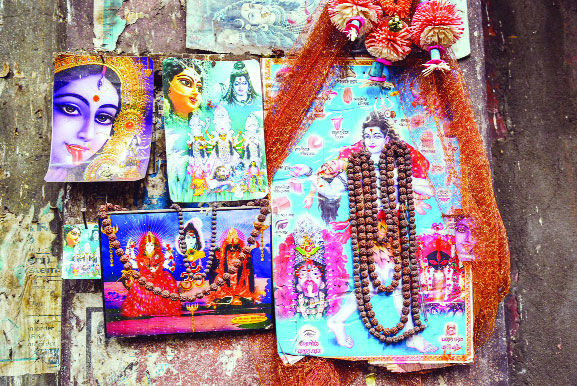A pilgrim, S C Sekhar captures the journey for salvation in a beautiful way, says Uma Nair
A set of scarlet-painted trishuls set against a wall made S C Sekhar stop on the roadside and capture a stunning still life. The way to to Sikkim held many such unforgettable vistas and vignettes. Opening at the Shridharani Gallery today is an unforgettable odyssey of a photographer who has spent the past four decades capturing myriad facets of India. This suite of images is called Faith, which gives the viewer a glimpse into the search for the spirit when a photographer turns into a pilgrim.
“I travelled as a pilgrim to Kailash and Mansarovar, visited the Maha Kumbh in 2013 and made trips to Varanasi in search of faith as an experience. Each experience gave me a richness of space and of time. Dawn at Varanasi was different from dusk. The light in the ancient city changes like a fabric that celebrates the colours of the sky and the sun,” says Sekhar. The show straddles the colours of faith as it were, within the sacred spaces of sadhus, of worshippers, of the corridors of silence in a monastery and a series of stunning landscapes and still lifes.
“The Maha Kumbh Mela proved India is steeped in ancient traditions,” says Sekhar. “Hinduism is an ancient religion, 5,000 years old. It was intriguing to see the modern and the ancient collide, all becoming one humanity to dip into the Ganges. There were 70 to 100 million people in one place. And the sadhus were both distinct and professional posers!”
Searching for salvation
The Maha Kumbh Mela of 2013 becomes a chess board of characters spinning a tale of ritual ascetics and aesthetics, the ash-laden foreheads, decorated necks and embellished rudraakshas often alluding to the architecture of relics and the many facets of both the human visage and the human body.
The portraits of the sadhus address temporal, spatial and social relationships of language, history and the present. Their faces materialise in response to contextual conditions or the premises of the given moment for the search for salvation.
“At the Kumbh, the bathing is officially opened at dawn by naked Hindu ascetics from the revered Naga warrior sect, founded as protectors more than 800 years ago,” says Sekhar. The Nagas, with their long hair, flowing beards and ash-covered bodies, wave swords, tridents and spears invoke the blessing of the Ganges as they run into the water.
“They immerse themselves in knee-deep water at the sangam or spot where the Ganges converges with the Yamuna and the mythical, underground Saraswati river which, according to ancient texts, embodies true knowledge. It is a scene that is rigorous as well as fascinating. I was also fascinated by a five-year-old boy who sat and gazed at me in silence,” says Sekhar.
Stunning Still lifes
Sekhar brings personal histories to his stunning still life series. There are two subtexts here — the first, a series of ritual-related studies and the second the boats of Varanasi as well as images of dawn at the Hooghly. They serve as a reflection of the present and the multiple rituals reflected in the artistic process of meditative repetition. The rudraaksha added to a calendar image adds a third dimension.
Scents and smells abound as you gaze at the pictures of little leaf containers with petals and prasad for aarti. It is almost as if the images bring forth the aura of sandalwood, honey, milk, roses and fragrant jasmine.
These still life forms in Varanasi tell us that devotion and death are intimately a part of ordinary life, sharing a connection that is as old as history.
Improvisation and anthropology intersect in the ambient luminosity of mysticism and the dilapidated city of Varanasi. Sekhar understands the mysteries a little better by furrowing the river where he captures it at dawn when it is veiled with mist, at dusk when the crowd joins the ghats for pujas, morning prayers, or during Dev Deepawali to glimpse the floating diyas.
Steeped in prayer
“There are cities so removed from the fast-paced everyday world, that still so steeped in prayer,” says Sekhar. Walking the hilly pathways at Mansarovar with Shankaracharya of Hampi became a lesson in learning of the mosaic of life’s texts to understand the riverine rhythms and resonance.
“I experienced a sense of calm, serenity and unexplained devotion,” explains Sekhar and adds, “Suddenly everything around me fell into place. In the spritual journey, the devotion and beliefs of people of multiple faiths became a part of one canvas.”
The lunar landscape of burnished red and white rock continues further west to the pre-Buddhist kingdom of Guge. Represented as a sheltered world, mirroring the surrounding tropical cosmos and its equatorial firmament, Mansarovar mutates into a zone and a space of contemplation. These images feel other-worldly. They capture scenic undulations of cold desert landscapes where pastorals present the perfect idyll. Even the image of a door in Sikkim can present a harvest of intensities in which earth tenors and terrain have soft and gentle evocations of both time and tide.
Faith for Sekhar is about endlessly converting time, energy, thinking and realisation. “When I click a photograph, it is about freedom,” says Sekhar. “Not only am I free as a creator, the viewers are free as spectators as well.”
The show runs at Shridharani Gallery till September 20.
Writer: Uma Nair
Courtesy: The Pioneer








 OpinionExpress.In
OpinionExpress.In















Comments (0)